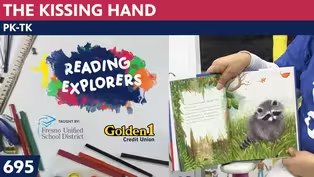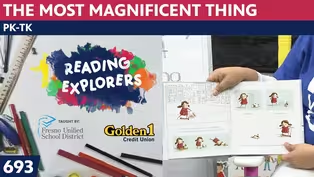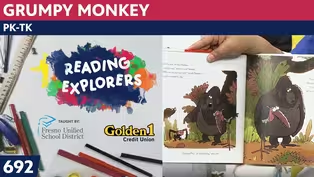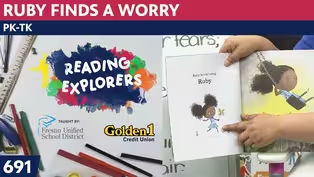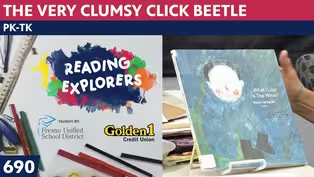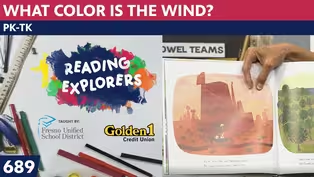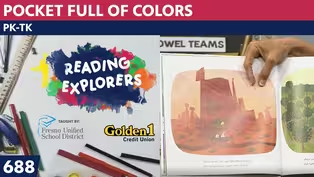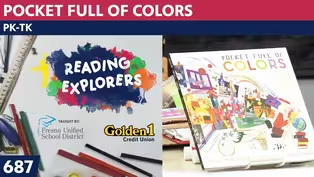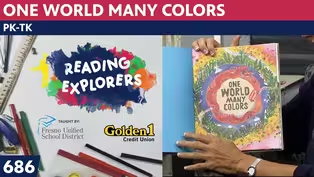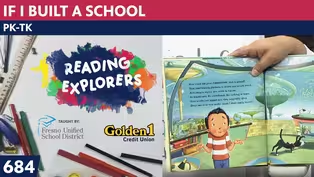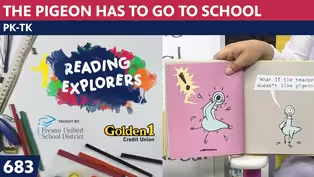
TK-336: Paul Klee
Season 3 Episode 192 | 13m 43sVideo has Closed Captions
Join Mrs. Readwright at Camp Discovery!
Transitional Kindergarten teacher, Mrs. Readwright, welcomes students back to Camp Discovery, a fun learning space packed with reading adventures & fun games!
Problems playing video? | Closed Captioning Feedback
Problems playing video? | Closed Captioning Feedback
Reading Explorers is a local public television program presented by Valley PBS

TK-336: Paul Klee
Season 3 Episode 192 | 13m 43sVideo has Closed Captions
Transitional Kindergarten teacher, Mrs. Readwright, welcomes students back to Camp Discovery, a fun learning space packed with reading adventures & fun games!
Problems playing video? | Closed Captioning Feedback
How to Watch Reading Explorers
Reading Explorers is available to stream on pbs.org and the free PBS App, available on iPhone, Apple TV, Android TV, Android smartphones, Amazon Fire TV, Amazon Fire Tablet, Roku, Samsung Smart TV, and Vizio.
Providing Support for PBS.org
Learn Moreabout PBS online sponsorshipMore from This Collection
Valley PBS and Fresno Unified School District have partnered with Golden 1 Credit Union to create Reading Explorers Lessons for grades Pre-Kindergarten through Third grade. The daily lessons will be taught by Fresno Unified School District teachers and are created to help students practice their reading skills and reinforce lessons during distance learning.
Video has Closed Captions
Valley PBS presents Reading Explorers Lessons for Pre-Kindergarten and TK. (26m 27s)
PK-TK-693-The Most Magnificent Thing
Video has Closed Captions
Valley PBS presents Reading Explorers Lessons for Pre-Kindergarten and TK. (26m 26s)
Video has Closed Captions
Valley PBS presents Reading Explorers Lessons for Pre-Kindergarten and TK. (26m 28s)
Video has Closed Captions
Valley PBS presents Reading Explorers Lessons for Pre-Kindergarten and TK. (26m 28s)
PK-TK-690: The Very Clumsy Click Beetle
Video has Closed Captions
Valley PBS presents Reading Explorers Lessons for Pre-Kindergarten and TK. (26m 22s)
PK-TK-689: What Color is the Wind?
Video has Closed Captions
Valley PBS presents Reading Explorers Lessons for Pre-Kindergarten and TK. (26m 21s)
PK-TK-688: Pocket Full of Colors
Video has Closed Captions
Valley PBS presents Reading Explorers Lessons for Pre-Kindergarten and TK. (25m 58s)
PK-TK-687: Dancing Through Fields of Colors
Video has Closed Captions
Valley PBS presents Reading Explorers Lessons for Pre-Kindergarten and TK. (26m 20s)
PK-TK-686: One World Many Colors
Video has Closed Captions
Valley PBS presents Reading Explorers Lessons for Pre-Kindergarten and TK. (27m 13s)
PK-TK-685: School is Wherever I am
Video has Closed Captions
Valley PBS presents Reading Explorers Lessons for Pre-Kindergarten and TK. (26m 32s)
PK-TK-684: If I Built a School
Video has Closed Captions
Valley PBS presents Reading Explorers Lessons for Pre-Kindergarten and TK. (26m 21s)
PK-TK-683: The Pigeon Has to Go to School
Video has Closed Captions
Valley PBS presents Reading Explorers Lessons for Pre-Kindergarten and TK. (26m 22s)
Providing Support for PBS.org
Learn Moreabout PBS online sponsorship- Hello, early learners.
And welcome back to the art room.
It's me, Mrs. Readwright.
Let's start off with our hello song.
♪ Hello, nice to see you, everyone ♪ ♪ Hello, nice to see you, everyone ♪ ♪ Hello to you ♪ ♪ Hello to you ♪ ♪ Hello to you ♪ ♪ Hello to me ♪ ♪ Hello, nice to see you, everyone ♪ It is mystery Monday and I do have the suitcase.
But since we already know we're doing the alphabet for the next 21 days, we don't need to look inside because we know what our topic is.
But let's see the alphabet song for this week.
It goes like this.
♪ A, B, C, D, E of art ♪ ♪ That's the way that we will start ♪ ♪ F is for fish ♪ ♪ Goldfish starts with a G ♪ ♪ H is for house, now don't use see ♪ ♪ I is for insect ♪ ♪ Jar starts with J ♪ ♪ Art and the alphabet, what do you say ♪ So you know we're going to do things about fish, two days.
We're going to do something about insects, and houses, and about a jar.
So we have a lot of things to do, and we're going to be using some materials that you may not have used before.
We're using a straw today.
I brought one that's striped.
If you don't have a straw, you'll just use your breath, 'cause we're just going to move some paint around.
But let's talk about who we are meeting today.
And it's an old friend that we know from before, when we did Senecio, that big headed man.
It was done by Paul Klee.
Now, Paul Klee, remember we learned that his name is spelled K-L-E-E, but we say clay.
And here he is in his studio, and he painted this.
Let's hear the rhyme about fish.
It says, Paul Klee painted these colorful fish.
You can create them any color you wish.
So most of his paintings were small and colorful.
And he was known as an artist that did things in a childlike way.
Remember, he was born in Switzerland, and he came from a family of musicians, and he was a musician for a long time.
And his grandma gave him that box of chalks.
And he thought doing chalk art was way more fun than being a musician.
And his wife was a piano teacher, and he used to do his art in their kitchen, and she would teach piano.
And he did over 9,000 pieces of art before he passed away.
So let's take a look at his art, and what we're going to be doing.
This art was actually done by scratching.
We're not going to do that, because when I was a little girl, in my art class, we did the scratch art.
And the classroom became a huge mess, because what you do is you paint your paper, and then you cover the whole thing with black crayon, so hard, you keep coloring until you can't see any color beneath the black crayon.
Then you get a paper clip and you scratch through the black crayon, and it unveils or uncovers the color below.
So in this picture, the fish are all scratched through black paint.
And what we're going to do is first make our paper colorful.
I did one yesterday, so that it would be dry and ready for you to see.
But we're going to do one today, so that you'll know how to do it, but you won't be able to do the black today, because this will have to dry overnight.
But I'm going to show you the two steps to make the art and the fish.
Now, look at this paper.
You can tell that it didn't get this color by me painting it.
I dripped, dripped, dripped paint on there.
And then I took my straw, and blew it all over the paper.
So if you have a straw and paints today, you can do this with me right now.
Otherwise, just save this project for when you're in the kitchen or out on the patio with your paints, and then you can let it dry overnight.
And then you'll do the second step.
Let me set this over here while I get my fresh paper.
And I remembered to bring a little bit of newspaper, so I don't get so much paint on my little table board.
I'll open it up, and set it here, and put my paper on it.
All right.
Now, I have the fanciest brush you have ever seen.
Let me bring it and show you.
Look.
It has water in the handle and the water gets pressed up into the brush.
It's just a regular brush, but it's filled with water.
And what I've done is put a lot of water in my watercolor pans.
I don't suggest you do that when you're painting regularly.
But to do this project, you need big drops of paint.
So I'm dipping into the paint, and then I'm going to drip it on my paper.
And I put pretty colors together that will look good together.
I'm gonna clean my brush in between.
I don't want any labels to show here, let you know what I'm eating and drinking at home.
And I'll put this orange next to that red-orange and drip, drip, drip it.
And I'll bring over some of my yellow, because this one doesn't have yellow in it.
Some of our watercolors have bright colors, some have primary colors, some have just the secondary colors.
So I'm going to put a combination, 'cause I think that you'll like to see the yellow mixed in.
So let me mix this around and get some paint on here, 'cause really, it's still just water there.
And drip, drip, drip, drip, drip.
Now, I'm ready to use my straw, and watch.
I have this end, so I remember.
But look, I can do it with my breath, (breath blowing) it's harder that way.
(breath rustles) See how smart I was to put the newspaper on there?
'Cause otherwise, it would have flown off onto the floor.
(breath blowing) Now, I'm gonna use some different combinations of colors.
I have to get the paint off of that part of the brush.
I think this turquoise color will be pretty, if I put it over here a little bit.
'Cause some of my fish might be blue.
Some might be green.
Some might be orange.
It just depends on what colors I put on my paper and blow around on here.
See what I'm doing.
Drip, drip, drip.
And you can put as many drips as you want.
I don't want to get too much paint on here, 'cause I don't know how many fish I feel like drawing.
So now I use my straw.
(breath blowing) And if I didn't already have turquoise, when it mixed with the green, it would have made more of a blue-green.
I'm gonna put some, oh, let's put some purple and magenta together.
Drip, drip, drip.
I have to wash my brush and get into the next color.
These brushes, I don't even know where they come from, it was in my set of metallic paints I bought, and it was just sitting there, and I said, "What kind of paintbrush is this?"
And now I want a bunch of them.
So I'll find out about them, and I'll put it on my webpage.
(breath blowing) So you have the idea of how this is done.
Now I'm going to show you how we're going to do the black part.
Now remember, this isn't going to be the scratch kind.
But I wanted you to know how that's done.
You just put layers and layers of crayon on top of each other.
This week, another day, we're going to use a straw too, we're gonna blow on some colors too.
So make sure if you don't have a lot of straws, just save one for that project.
Okay, I'm gonna move this over to dry.
I don't care if it drips, 'cause it's really a drippy artwork.
There we go.
Go on over here.
And I'll bring over the dry one.
Let me move the newsprint, so that I don't get any paint on any furniture.
'Cause you know, I'm sitting in a chair that has cloth on it, and if I get paint on it, I didn't bring my cloth cleaner today.
I'd have to clean this chair.
Set this over here and get the other one up.
Now, I will have to draw my fish shapes on top of here, I am using chalk pastels.
This is different from the chalk you'd draw on the sidewalk with, this is artist chalk, and it's not very expensive if you decide to buy some.
So I want my fish, this one, to have purple and magenta.
So I'm going to draw the shape, that's kind of like an eye, but not close it up at the end.
I'll put a triangle at the back side, like that.
Now, I will make it a little darker on here, because I am going to push the black around, because Klee's work has black all around his fish.
There will still be some color showing, but I want to get this here, and you notice, I'm putting it down, and pushing it out.
Putting it down on the line and pushing out.
Put it on the line, push it out, push it out, push it out.
♪ You got to push, push, push it out ♪ ♪ You gotta push, push, push it out ♪ ♪ Push, push ♪ But now I'm pulling it to me, 'cause it's coming toward me.
♪ Pull, pull, pull it out ♪ ♪ You gotta pull, pull, pull it out ♪ That's my first fish.
Let me show you the process that I'm going to use to blend it.
With me today, I brought a piece of paper towel.
And I brought a little wet rag.
So watch, if I don't want this black, See how much black got on my fingers?
I just rub it on the wet rag, if I need to pick up anything else.
And then I dry it on the dry rag, and I'm ready.
But this is what I'm going to do.
If you'd rather put a little piece of paper towel around your finger, let me show you what that would look like, and rub it out that way.
Just rub it out from the fish on the edge and out.
Edge and out.
Edge and out.
Out, out, out, out.
Out, out, out.
You see this process is gonna take us a little while, so I'm not rushing, because if I rush and go in too close, I will make my fish all black on the inside, and I don't want to do that.
When you work on it, you start on the top and move toward you.
Because every time you go down, you'll drag your hand across the black.
So start at the top and pull down.
Now, if I wanted to work down here, I would just move my paper up to the top.
I'm gonna tap this on here, get some of the chalk off.
Now, I also brought a white pen, in case I wanted put any squiggles and wiggles like Paul Klee did on his work.
And I'm just making some squiggles and wiggles.
You can use a crayon.
You can decide what looks best for you.
I also brought a black permanent pen, so I can give him an eye.
I'm gonna give him an eye right here, and add that to that.
And I might even make a little mouth go up.
I'm gonna do another fish before we have to say goodbye to each other.
'Cause I think you might like to see that happen again.
Ooh, I'm getting it all under my fingernails.
That's gonna be a mess when I go somewhere else today.
So I might make my fish swimming this way, an eye-shaped...
Boys and girls, tomorrow, we're going to talk about a gold fish with Henri Matisse.
And I want you to bring a pencil, colored pencils, or any coloring tools that you might use.
And I will see you then.
So let's sing goodbye to one another.
♪ Good bye, see you next time, everyone ♪ ♪ Good bye, see you next time, everyone ♪ Bye, everyone, see you tomorrow.
Thanks for joining me today.
(upbeat guitar music) ♪ Good morning to a brand new day ♪ ♪ Time to learn and games to play ♪ ♪ Learning things is so much fun ♪ ♪ Learning is good for everyone ♪
Support for PBS provided by:
Reading Explorers is a local public television program presented by Valley PBS
